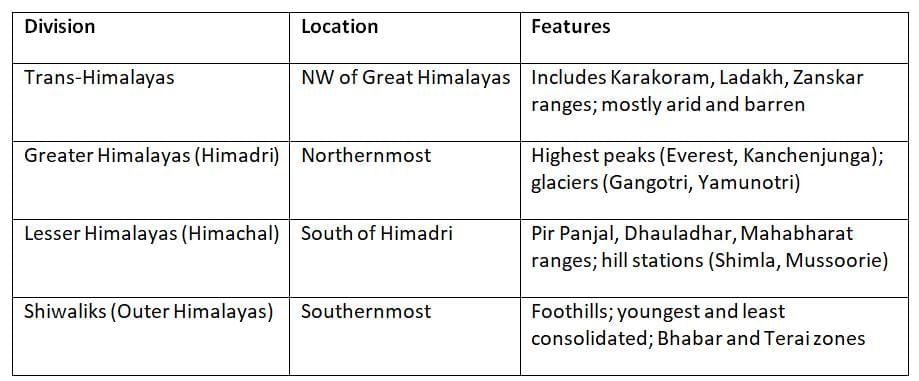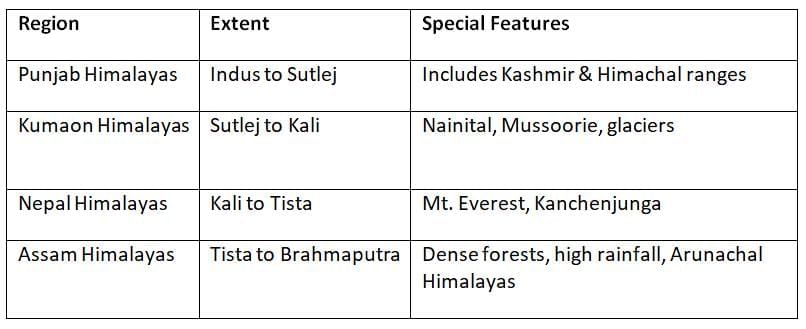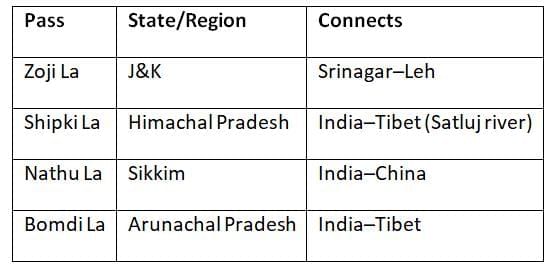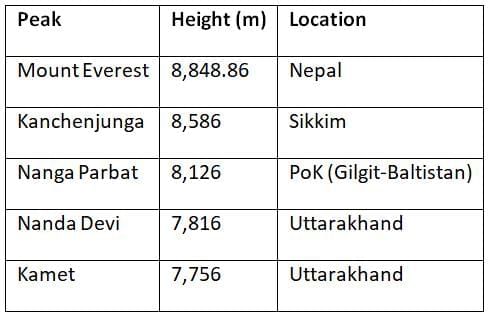UPSC Exam > UPSC Notes > Geography for UPSC CSE > Cheat Sheet: The Himalayas (Northern Mountains)
Cheat Sheet: The Himalayas (Northern Mountains) | Geography for UPSC CSE PDF Download
| Table of contents |

|
| Introduction |

|
| Longitudinal Division of Himalayas |

|
| Regional Divisions of Himalayas |

|
| Important Passes in Himalayas |

|
| Important Peaks |

|
| Significance of Himalayas |

|
| Issues Related to Himalayas |

|
Introduction
Formed by collision of Indian and Eurasian plates (Tertiary orogeny).
- Classified as young fold mountains.
- Stretch: From Indus gorge (Nanga Parbat) in the west to Brahmaputra gorge (Namcha Barwa) in the east (~2,400 km).
- Width: 250–400 km; Average elevation: 6,000 m.
Longitudinal Division of Himalayas

Regional Divisions of Himalayas

Important Passes in Himalayas

Important Peaks

Significance of Himalayas
- Climatic Barrier: Prevents cold Siberian winds; causes monsoon rains.
- Source of Rivers: Ganga, Yamuna, Indus, Brahmaputra.
- Rich Biodiversity: Alpine to tropical vegetation.
- Strategic Importance: Natural boundary; military significance.
- Tourism and Pilgrimage: Hill stations, religious places (Kedarnath, Badrinath).
Issues Related to Himalayas
- Landslides and Earthquakes: Due to tectonic instability.
- Glacier Retreat: Climate change impact.
- Deforestation: Pressure from population and tourism.
- River Pollution: In densely populated valleys.
The document Cheat Sheet: The Himalayas (Northern Mountains) | Geography for UPSC CSE is a part of the UPSC Course Geography for UPSC CSE.
All you need of UPSC at this link: UPSC
|
264 videos|875 docs|232 tests
|
FAQs on Cheat Sheet: The Himalayas (Northern Mountains) - Geography for UPSC CSE
| 1. What are the main regional divisions of the Himalayas? |  |
Ans. The Himalayas are primarily divided into three main regions: the Greater Himalayas (Himadri), the Lesser Himalayas (Himachal), and the Outer Himalayas (Shivalik). The Greater Himalayas are the highest and include some of the tallest peaks such as Mount Everest. The Lesser Himalayas consist of several mountain ranges and valleys, while the Outer Himalayas, also known as the Shivalik range, are the foothills and have a lower elevation.
| 2. What are some important passes located in the Himalayas? |  |
Ans. The Himalayas are home to several important passes that serve as significant routes for trade and travel. Notable passes include the Nathu La, which connects India and Tibet, the Zoji La, which connects Srinagar to Leh, and the Khardung La, known for being one of the highest motorable roads in the world. These passes not only facilitate transportation but also have historical and strategic importance.
| 3. Why are the Himalayas considered significant for the environment and ecology? |  |
Ans. The Himalayas play a crucial role in the environment by acting as a barrier to monsoon winds, thereby influencing the climate of the Indian subcontinent. They are also a vital water source, feeding major rivers such as the Ganges, Indus, and Brahmaputra. Additionally, the diverse ecosystems of the Himalayas are home to unique flora and fauna, making them important for biodiversity conservation.
| 4. What are some of the major peaks in the Himalayas? |  |
Ans. The Himalayas boast numerous prominent peaks, with Mount Everest (8,848 m) being the highest in the world. Other significant peaks include K2 (8,611 m), Kangchenjunga (8,586 m), Lhotse (8,516 m), and Makalu (8,485 m). These peaks are not only important for mountaineering but also hold cultural and spiritual significance for local populations.
| 5. What are some of the key issues facing the Himalayas today? |  |
Ans. The Himalayas face several pressing issues, including climate change, which is causing glacial melting and altering water supply patterns. Deforestation, habitat loss, and land degradation due to human activities also pose significant threats. Additionally, socio-economic challenges such as poverty, migration, and the impacts of tourism can strain local resources and ecosystems, necessitating sustainable management practices.
Related Searches















